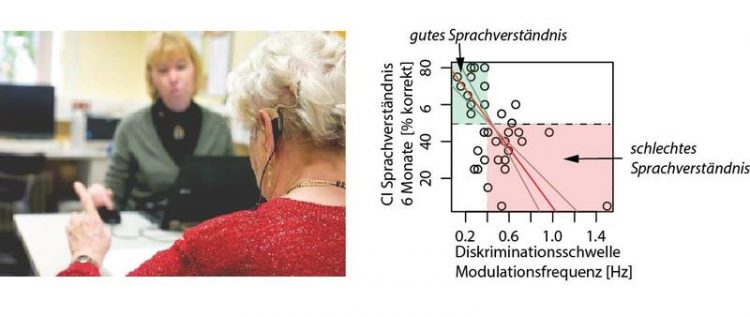Speech comprehension with a cochlear implant

Speech comprehension with a cochlear implant IPSY / Universität zu Lübeck
Currently the only neuroprostheses that can successfully replace a sensory organ are cochlear implants: They can restore hearing in deaf patients. Cochlear implants pick up sound and translate it into an electric signal which is transmitted directly to the auditory nerve, thus by-passing the damaged middle or inner ear.
The transduced sound signal is considerably distorted, however, sounding like a “harsh whisper”, as some patients would describe it. Cochlear implant recipients vary largely in how well they adapt to their device: Some learn to comprehend speech even under difficult listening condi¬tions, such as on the phone or in a pub, while others hardly benefit from their device. The source of this variability is still elusive.
Previous studies have shown that clinical factors such as duration of deafness clearly influence speech recognition with a cochlear implant. A recent study demonstrates that non-speech temporal auditory abilities also contribute considerably to speech outcome (doi: 10.1097/AUD.0000000000000588).
Researchers at the Max Planck Institute for Human Cognitive and Brain Sciences, the Cochlear Implant Center Leipzig, and the University of Lübeck tested newly implanted adults on their capacity to hear temporal modulations in noise. This novel hearing test turned out to be highly correlated with future speech recognition: Patients, who could better hear temporal modulations were also the ones, who had a better speech comprehension six months later. In contrast, the ones with poor auditory temporal resolution had an increased risk of poor future speech comprehension.
For the growing number of cochlear implant patients (to date approximately 150 000 in Europe), this adaptation process is a vital necessity. After a period of deafness, adjusting to the extremely degraded, unfamiliar signal delivered by the implant enables the listener to extract meaning from a messy auditory signal. Novel, reliable hearing tests are essential with respect to two points: On the one hand, they allow to identify poor performers early on and to consequently prescribe appropriate training measures. On the other hand, they can help to improve CI algorithms on an individual basis.
Erb J, Ludwig AA, Kunke D, Fuchs M, & Obleser J. Temporal sensitivity measured shortly after cochlear implantation predicts six-month speech recognition outcome (Ear Hear. 2018 Apr 24. doi: 10.1097/AUD.0000000000000588. [Epub ahead of print]).
Media Contact
More Information:
http://www.uni-luebeck.deAll latest news from the category: Medical Engineering
The development of medical equipment, products and technical procedures is characterized by high research and development costs in a variety of fields related to the study of human medicine.
innovations-report provides informative and stimulating reports and articles on topics ranging from imaging processes, cell and tissue techniques, optical techniques, implants, orthopedic aids, clinical and medical office equipment, dialysis systems and x-ray/radiation monitoring devices to endoscopy, ultrasound, surgical techniques, and dental materials.
Newest articles

Why getting in touch with our ‘gerbil brain’ could help machines listen better
Macquarie University researchers have debunked a 75-year-old theory about how humans determine where sounds are coming from, and it could unlock the secret to creating a next generation of more…

Attosecond core-level spectroscopy reveals real-time molecular dynamics
Chemical reactions are complex mechanisms. Many different dynamical processes are involved, affecting both the electrons and the nucleus of the present atoms. Very often the strongly coupled electron and nuclear…

Free-forming organelles help plants adapt to climate change
Scientists uncover how plants “see” shades of light, temperature. Plants’ ability to sense light and temperature, and their ability to adapt to climate change, hinges on free-forming structures in their…





















